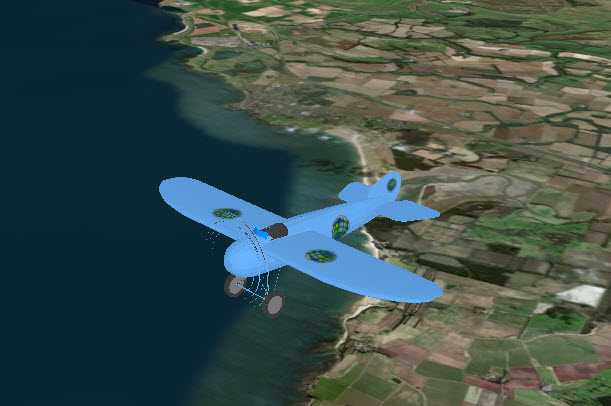Change a graphic's symbol based on the camera's proximity to it.

Use case
When showing dense datasets, it is beneficial to reduce the detail of individual points when zooming out to avoid visual clutter and to avoid data points overlapping and obscuring each other.
How to use the sample
The sample starts looking at a plane. Zoom out from the plane to see it turn into a cone. Keeping zooming out and it will turn into a point.
How it works
- Create a
GraphicsOverlayobject and add it to aSceneViewobject. - Create a
DistanceCompositeSceneSymbolobject. - Create
DistanceSymbolRangeobjects specifying aSymboland the min and max distance within which the symbol should be visible. - Add the ranges to the range collection of the distance composite scene symbol.
- Create a
Graphicobject with the distance composite scene symbol at a location and add it to the graphics overlay.
Relevant API
- DistanceCompositeSceneSymbol
- Range
- RangeCollection
Tags
3D, data, graphic, range, symbol
Sample Code
UseDistanceCompositeSym.cs
// Copyright 2017 Esri.
//
// Licensed under the Apache License, Version 2.0 (the "License"); you may not use this file except in compliance with the License.
// You may obtain a copy of the License at: http://www.apache.org/licenses/LICENSE-2.0
//
// Unless required by applicable law or agreed to in writing, software distributed under the License is distributed on an
// "AS IS" BASIS, WITHOUT WARRANTIES OR CONDITIONS OF ANY KIND, either express or implied. See the License for the specific
// language governing permissions and limitations under the License.
using System;
using System.Threading.Tasks;
using ArcGISRuntime.Samples.Managers;
using Esri.ArcGISRuntime.Geometry;
using Esri.ArcGISRuntime.Mapping;
using Esri.ArcGISRuntime.Symbology;
using Esri.ArcGISRuntime.UI;
using Esri.ArcGISRuntime.UI.Controls;
using Foundation;
using UIKit;
namespace ArcGISRuntime.Samples.UseDistanceCompositeSym
{
[Register("UseDistanceCompositeSym")]
[ArcGISRuntime.Samples.Shared.Attributes.Sample(
name: "Distance composite scene symbol",
category: "Symbology",
description: "Change a graphic's symbol based on the camera's proximity to it.",
instructions: "The sample starts looking at a plane. Zoom out from the plane to see it turn into a cone. Keeping zooming out and it will turn into a point.",
tags: new[] { "3D", "data", "graphic", "range", "symbol" })]
[ArcGISRuntime.Samples.Shared.Attributes.OfflineData("681d6f7694644709a7c830ec57a2d72b")]
public class UseDistanceCompositeSym : UIViewController
{
// Hold references to UI controls.
private SceneView _mySceneView;
public UseDistanceCompositeSym()
{
Title = "Distance composite symbol";
}
private async void Initialize()
{
try
{
// Create a new Scene with an imagery basemap.
Scene myScene = new Scene(BasemapStyle.ArcGISImageryStandard);
// Add the Scene to the SceneView.
_mySceneView.Scene = myScene;
// Create a new GraphicsOverlay and add it to the SceneView.
GraphicsOverlay graphicsOverlay = new GraphicsOverlay();
graphicsOverlay.SceneProperties.SurfacePlacement = SurfacePlacement.Relative;
_mySceneView.GraphicsOverlays.Add(graphicsOverlay);
// Call a function to create a new distance composite symbol with three ranges.
DistanceCompositeSceneSymbol compositeSymbol = await CreateCompositeSymbol();
// Create a new point graphic with the composite symbol, add it to the graphics overlay.
MapPoint locationPoint = new MapPoint(-2.708471, 56.096575, 5000, SpatialReferences.Wgs84);
Graphic pointGraphic = new Graphic(locationPoint, compositeSymbol);
graphicsOverlay.Graphics.Add(pointGraphic);
// Add an orbit camera controller to lock the camera to the graphic.
OrbitGeoElementCameraController cameraController = new OrbitGeoElementCameraController(pointGraphic, 20)
{
CameraPitchOffset = 80,
CameraHeadingOffset = -30
};
_mySceneView.CameraController = cameraController;
}
catch (Exception e)
{
// Something went wrong, display the error.
UIAlertController alert = UIAlertController.Create("Error", e.Message, UIAlertControllerStyle.Alert);
alert.AddAction(UIAlertAction.Create("OK", UIAlertActionStyle.Default, null));
PresentViewController(alert, true, null);
}
}
private async Task<DistanceCompositeSceneSymbol> CreateCompositeSymbol()
{
// Get the path to the 3D model.
string modelPath = GetModelPath();
// Create three symbols for displaying a feature according to its distance from the camera.
// First, a 3D model symbol (airplane) for when the camera is near the feature.
ModelSceneSymbol plane3DSymbol = await ModelSceneSymbol.CreateAsync(new System.Uri(modelPath), 1.0);
// 3D (blue cone) symbol for when the feature is at an intermediate range.
SimpleMarkerSceneSymbol coneSym = new SimpleMarkerSceneSymbol(SimpleMarkerSceneSymbolStyle.Cone, System.Drawing.Color.LightSkyBlue, 15, 6, 3, SceneSymbolAnchorPosition.Center)
{
// The cone will point in the same direction as the plane.
Pitch = -90
};
// Simple marker symbol (circle) when the feature is far from the camera.
SimpleMarkerSymbol markerSym = new SimpleMarkerSymbol(SimpleMarkerSymbolStyle.Circle, System.Drawing.Color.LightSkyBlue, 10.0);
// Create three new ranges for displaying each symbol.
DistanceSymbolRange closeRange = new DistanceSymbolRange(plane3DSymbol, 0, 100);
DistanceSymbolRange midRange = new DistanceSymbolRange(coneSym, 100, 500);
DistanceSymbolRange farRange = new DistanceSymbolRange(markerSym, 500, 0);
// Create a new DistanceCompositeSceneSymbol and add the ranges.
DistanceCompositeSceneSymbol compositeSymbol = new DistanceCompositeSceneSymbol();
compositeSymbol.Ranges.Add(closeRange);
compositeSymbol.Ranges.Add(midRange);
compositeSymbol.Ranges.Add(farRange);
// Return the new composite symbol.
return compositeSymbol;
}
private static string GetModelPath()
{
return DataManager.GetDataFolder("681d6f7694644709a7c830ec57a2d72b", "Bristol.dae");
}
public override void ViewDidLoad()
{
base.ViewDidLoad();
Initialize();
}
public override void LoadView()
{
// Create the views.
View = new UIView() { BackgroundColor = ApplicationTheme.BackgroundColor };
_mySceneView = new SceneView();
_mySceneView.TranslatesAutoresizingMaskIntoConstraints = false;
// Add the views.
View.AddSubviews(_mySceneView);
// Lay out the views.
NSLayoutConstraint.ActivateConstraints(new[]
{
_mySceneView.TopAnchor.ConstraintEqualTo(View.SafeAreaLayoutGuide.TopAnchor),
_mySceneView.BottomAnchor.ConstraintEqualTo(View.BottomAnchor),
_mySceneView.LeadingAnchor.ConstraintEqualTo(View.LeadingAnchor),
_mySceneView.TrailingAnchor.ConstraintEqualTo(View.TrailingAnchor)
});
}
}
}